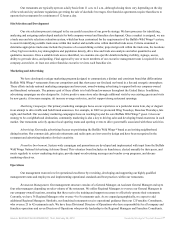Buffalo Wild Wings 2009 Annual Report Download - page 19
Download and view the complete annual report
Please find page 19 of the 2009 Buffalo Wild Wings annual report below. You can navigate through the pages in the report by either clicking on the pages listed below, or by using the keyword search tool below to find specific information within the annual report.
ITEM 1A. RISK FACTORS
The foregoing discussion and the discussion contained in Item 7 of this Form 10-K contain various “forward-looking
statements” within the meaning of Section 27A of the Securities Act of 1933, as amended, and Section 21E of the Securities Exchange
Act of 1934, as amended. Forward-looking statements are based on current expectations or beliefs concerning future events. Such
statements can be identified by the use of terminology such as “anticipate,” “believe,” “estimate,” “expect,” “intend,” “may,” “could,”
“possible,” “plan,” “project,” “will,” “forecast” and similar words or expressions. Our forward-looking statements generally relate to
our growth strategy, financial results, sales efforts, franchise expectations, store openings and related expense, and cash requirements.
Although it is not possible to foresee all of the factors that may cause actual results to differ from our forward-looking statements,
such factors include, among others, the risk factors that follow. Investors are cautioned that all forward-looking statements involve
risks and uncertainties and speak only as of the date on which they are made. We believe that all material risk factors have been
discussed below.
Fluctuations in chicken wing prices could reduce our operating income.
The primary food product used by our company-owned and franchised restaurants is chicken wings. We work to counteract
the effect of the volatility of chicken wing prices, which can significantly change our cost of sales and cash flow, with the introduction
of new menu items, effective marketing promotions, focused efforts on food costs and waste, and menu price increases. We also
explore purchasing strategies to reduce the severity of cost increases and fluctuations. We currently purchase our chicken wings at
market price. If a satisfactory long-term pricing agreement for chicken wings were to arise, we would consider locking in prices to
reduce our price volatility. Chicken wing prices in 2009 averaged 39.3% higher than 2008 as the average price per pound increased to
$1.70 in 2009 from $1.22 in 2008. If there is a significant rise in the price of chicken wings, and we are unable to successfully adjust
menu prices or menu mix or otherwise make operational adjustments to account for the higher wing prices, our operating results could
be adversely affected. For example, chicken wings accounted for approximately 25%, 21%, and 24% of our cost of sales in 2009,
2008, and 2007, respectively, with an annual average price per pound of $1.70, $1.22, and $1.28, respectively. A 10% increase in the
chicken wing costs for 2009 would have increased restaurant cost of sales by approximately $3.8 million. If the avian flu were to
affect our supply of chicken wings, our operations may be negatively impacted, as prices may rise due to limited supply. Additional
information related to chicken wing prices is included in Item 7 under “Results of Operations.”
If we are unable to successfully open new restaurants, our revenue growth rate and profits may be reduced.
To successfully expand our business, we must open new Buffalo Wild Wings ® restaurants on schedule and in a profitable
manner. In the past, we and our franchisees have experienced delays in restaurant openings and we may experience similar delays in
the future. Delays or failures in opening new restaurants could hurt our ability to meet our growth objectives, which may affect our
results of operations, the expectations of securities analysts and shareholders and thus our stock price. We cannot guarantee that we or
our franchisees will be able to achieve our expansion goals. Further, any restaurants that we, or our franchisees, open may not achieve
operating results similar or better than our existing restaurants. If we are unable to generate positive cash flow from a new restaurant,
we may be required to recognize an impairment loss with respect to the assets for that restaurant. Our ability to expand successfully
will depend on a number of factors, many of which are beyond our control. These factors include:
• Locating suitable restaurant sites in new and existing markets;
• Having adequate restaurant sites due to tightening credit markets;
• Negotiating acceptable lease or purchase terms for new restaurants;
• Recruiting, training and retaining qualified home office, field and restaurant team members;
• Attracting and retaining qualified franchisees;
• Cost effective and timely planning, design and build-out of restaurants;
• Obtaining building materials and hiring satisfactory construction contractors;
Source: BUFFALO WILD WINGS INC, 10-K, February 26, 2010 Powered by Morningstar® Document Research℠
























